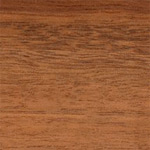Serving Upstate NY—VT—MA • For selections & prices, CALL or EMAIL US
Makore
Wood Flooring Species
Scientific Name:
Tieghemella heckelii
Other Names and Species:
Abacu
Aganokwe
African Cherry
Baku
Douka
Okolla
Origin:
Africa
Appearance:
The sapwood of makore is whitish to pale pink, while the heartwood is characterized by a spectrum of color ranging from pink to red to light brown. The species has a straight and sometimes interlocked grain and is medium to very fine in texture.
Properties:
Makore has a natural resistance to decay and termite attack. The wood remains smooth under friction and is reported to have no odor. Makore dries at a slightly slower rate than some other species, yet suffers little degrade in the process.
Janka Hardness: 1100
As a flooring option, makore falls close to black walnut in hardness. It is nearly eighty-five percent as hard as red oak, roughly seventy-five percent as hard as hard maple, about sixty percent as hard as hickory or pecan, and half the hardness of santos mahogany’s ranking of 2200.
Workability:
The high silica content in makore creates a noticable resistance to cutting tools. Pre-boring is suggested, since the wood can split when applying nails to it. Glue holds satisfactorilly well with makore flooring. This species sands fairly well and takes an excellent stain after filling. When moist, exposure to iron may stain the wood’s surface blue. The dust raised from working this wood has been known to cause skin, nose, and throat irritation in some people, so precautionary measures of some sort are advised.
Principal Uses:
Makore’s uses include kitchen cabinets, rustic furniture, tables, and shipbuilding.





